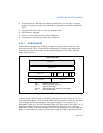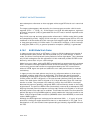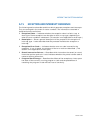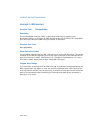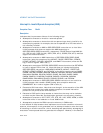
Vol. 3 6-29
INTERRUPT AND EXCEPTION HANDLING
Interrupt 1—Debug Exception (#DB)
Exception Class Trap or Fault. The exception handler can distinguish
between traps or faults by examining the contents of DR6
and the other debug registers.
Description
Indicates that one or more of several debug-exception conditions has been detected.
Whether the exception is a fault or a trap depends on the condition (see
Table 6-3).
See Chapter 16, “Debugging, Profiling Branches and Time-Stamp Counter,” for
detailed information about the debug exceptions.
Exception Error Code
None. An exception handler can examine the debug registers to determine which
condition caused the exception.
Saved Instruction Pointer
Fault — Saved contents of CS and EIP registers point to the instruction that gener-
ated the exception.
Trap — Saved contents of CS and EIP registers point to the instruction following the
instruction that generated the exception.
Program State Change
Fault — A program-state change does not accompany the debug exception, because
the exception occurs before the faulting instruction is executed. The program can
resume normal execution upon returning from the debug exception handler.
Trap — A program-state change does accompany the debug exception, because the
instruction or task switch being executed is allowed to complete before the exception
is generated. However, the new state of the program is not corrupted and execution
of the program can continue reliably.
Table 6-3. Debug Exception Conditions and Corresponding Exception Classes
Exception Condition Exception Class
Instruction fetch breakpoint Fault
Data read or write breakpoint Trap
I/O read or write breakpoint Trap
General detect condition (in conjunction with in-circuit emulation) Fault
Single-step Trap
Task-switch Trap





